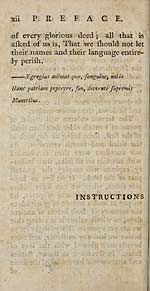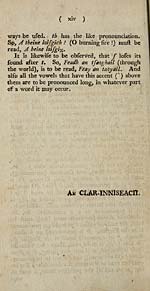Books and other items printed in Gaelic from 1631 to 1800 > Comh-chruinneachidh orannaigh Gaidhealach
(19) [Page xiii] - Instructions for reading the Gaelic language
Download files
Complete book:
Individual page:
Thumbnail gallery: Grid view | List view
![(19) [Page xiii] - Instructions for reading the Gaelic language](https://deriv.nls.uk/dcn17/9719/97194781.17.jpg)
I N S T R U C T r O N S
F O R R E A D^I N G T H E
GAELIC LANGUAGE.
FOR the more eafy perufal of this work to thofc
who are not expert in reading the langiiage,
thongh perhaps their mother-tongue, the follow-
ing general rules are laid down, called by our
grammarians the pronounciation of the fecondary
mutes, bh is always founded as a t; confonant ;
as, from Bru (a beily), Do bhru (thy belly), muft
be read as if written Do vru, ch as the Greek %,
or as the Scots pronounce the ch in the words
charaSìer and chaos : as, Mo chlann (my children),
muft be read as if written Mo ^lann, db before a
vowel, whether in the beginning or middle of a
word, has the fame pronounciation with y. So,
Dhofan (unto him), and Cradhach (tormenting),
muft be read as if written Tofan, Craya%. fh ìs
iiever at all pronounced. So, fhir ! (O man \),
fhutlfeìn (his own blood), muft be read ^ir !
^uìl fein. gh is commonly pronounced as dh ; fo
that thefe two letters are often ufed indifFerentìy.
mh is pronounced as a v confonant. So, Mo
mhallachd dhofan (my curfe unto him), muft be
read, Mij valla%d yofan. ^/^isalways pronounced
as in the Enghlh, fh is pronounced as h alone,
though / be commonly equal to the Enghlh fi.
So Sean (old), is to be read, Shean : but when the
fenfe is changed, as if one was faying, a fhean
duine ! (O old man!), the/is not to be pronoun-
ced, but read as if written'C? a heanduine ! But be-
jng (as we call it) the polTeffive letter, it muft al-
b ways
F O R R E A D^I N G T H E
GAELIC LANGUAGE.
FOR the more eafy perufal of this work to thofc
who are not expert in reading the langiiage,
thongh perhaps their mother-tongue, the follow-
ing general rules are laid down, called by our
grammarians the pronounciation of the fecondary
mutes, bh is always founded as a t; confonant ;
as, from Bru (a beily), Do bhru (thy belly), muft
be read as if written Do vru, ch as the Greek %,
or as the Scots pronounce the ch in the words
charaSìer and chaos : as, Mo chlann (my children),
muft be read as if written Mo ^lann, db before a
vowel, whether in the beginning or middle of a
word, has the fame pronounciation with y. So,
Dhofan (unto him), and Cradhach (tormenting),
muft be read as if written Tofan, Craya%. fh ìs
iiever at all pronounced. So, fhir ! (O man \),
fhutlfeìn (his own blood), muft be read ^ir !
^uìl fein. gh is commonly pronounced as dh ; fo
that thefe two letters are often ufed indifFerentìy.
mh is pronounced as a v confonant. So, Mo
mhallachd dhofan (my curfe unto him), muft be
read, Mij valla%d yofan. ^/^isalways pronounced
as in the Enghlh, fh is pronounced as h alone,
though / be commonly equal to the Enghlh fi.
So Sean (old), is to be read, Shean : but when the
fenfe is changed, as if one was faying, a fhean
duine ! (O old man!), the/is not to be pronoun-
ced, but read as if written'C? a heanduine ! But be-
jng (as we call it) the polTeffive letter, it muft al-
b ways
Set display mode to:
![]() Universal Viewer |
Universal Viewer | ![]() Mirador |
Large image | Transcription
Mirador |
Large image | Transcription
Images and transcriptions on this page, including medium image downloads, may be used under the Creative Commons Attribution 4.0 International Licence unless otherwise stated. ![]()
| Rare items in Gaelic > Books and other items printed in Gaelic from 1631 to 1800 > Comh-chruinneachidh orannaigh Gaidhealach > (19) [Page xiii] - Instructions for reading the Gaelic language |
|---|
| Permanent URL | https://digital.nls.uk/97194779 |
|---|
| Description | Out-of-copyright books printed in Gaelic between 1631 and 1900. Also some pamphlets and chapbooks. Includes poetry and songs, religious books such as catechisms and hymns, and different editions of the Bible and the Psalms. Also includes the second book ever published in Gaelic in 1631. |
|---|

